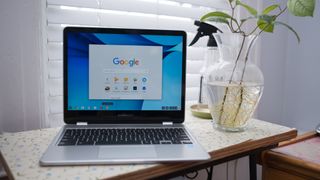Chromebooks are now better suited to remote work than ever
New improvements to Chrome OS help you get more done while working from home

Google is making it easier for users to work from home on their Chromebooks thanks to a number of new features included in the release of Chrome OS version 85.
Staying connected can be difficult for those using multiple Chromebooks or sharing notebooks among family members which is why the search giant has introduced a new Wi-Fi Sync feature in Chrome OS.
With Wi-Fi Sync, users will no longer need to reenter their Wi-Fi passwords when using a different Chromebook as they become part of the user profile's keychain and are stored to their accounts.
- We've put together a list of the best Chromebooks around
- Get more done with the best productivity tools
- Also check out the best online collaboration software
Google's AirDrop competitor Nearby Share, which allows users to easily share content with those around them, is now rolling out to Android devices but it will also be coming to Chromebooks.
Simplified settings
In addition to making it easier for users to share content and connect to their home Wi-Fi networks, Chrome OS 85 also reworks the operating system's settings menu.
The latest release provides users with an easier way to search for settings such as Bluetooth or Wi-Fi networks. It's clear that Google wants the Chromebook Launcher to serve as an “everything button” similar to how Spotlight works in Apple's iOS and macOS. According to the company, the ability to use Chrome OS' launcher to search through settings will be coming soon to Chromebooks.
To make being heard while video conferencing easier, Google has added a new mic slider in Chrome OS' Audio settings that allows users to control the volume of their voice to help others hear them better. Changing the volume of your microphone can be done by clicking on the volume icon in Quick Settings.
Are you a pro? Subscribe to our newsletter
Sign up to the TechRadar Pro newsletter to get all the top news, opinion, features and guidance your business needs to succeed!
Recording video will also be easier for Chrome OS users as Google will now let them pause and resume video recording as well as take still pictures while recording.
While Chrome OS first gained popularity in schools due to how easy Chromebooks are to setup and manage, Google is now positioning its operating system as an alternative to Windows and macOS for everyone including remote workers and even developers, who can now use it to develop Android apps.
- These are the best business laptops on the market
Via ZDNet
After working with the TechRadar Pro team for the last several years, Anthony is now the security and networking editor at Tom’s Guide where he covers everything from data breaches and ransomware gangs to the best way to cover your whole home or business with Wi-Fi. When not writing, you can find him tinkering with PCs and game consoles, managing cables and upgrading his smart home.
Most Popular

